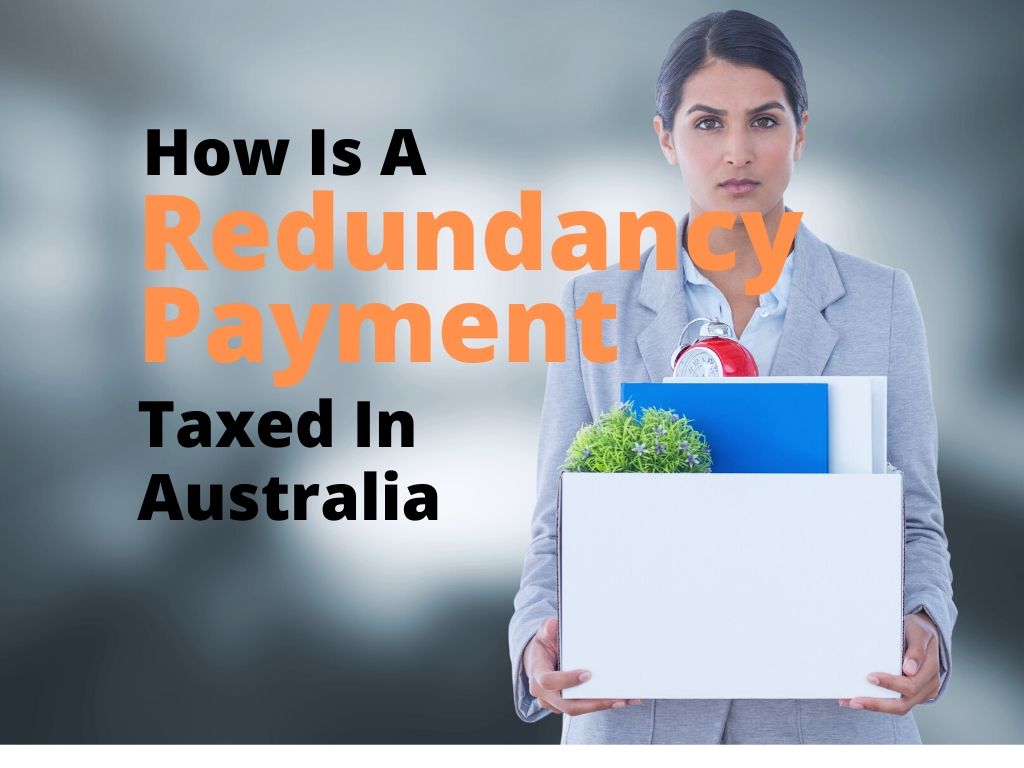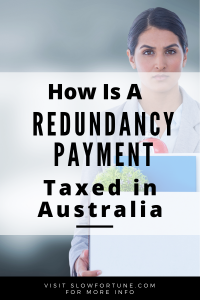
How Is a Redundancy Payment Taxed In Australia
Redundancy isn’t a pleasant experience and many people find it quite stressful. One of the common questions asked is “How are redundancy payments taxed in Australia?”
It’s a great question and thankfully taxation on redundancy payments is pretty simple once you understand the concepts. Bear in mind the information here is for Australians and based on the current Australian taxation rules.
What Do I Get Paid When I’m Made Redundant?
When you’re receiving a redundancy in Australia, your employer will pay out accrued leave and long service leave. In addition, depending on your workplace agreement and employment contract, you may receive:
- payment in lieu of notice
- a severance (redundancy) payment based on years of service
- possibly a ‘golden handshake’
The phrase ‘genuine redundancy payment’ is used a lot and is important to understand. A ‘genuine redundancy payment’ is where an employee is dismissed because their job no longer exists. A genuine redundancy payment receives some concessional tax treatment.
Your accrued leave (holiday leave and long service leave) is taxed separately to your redundancy payment. Based on the current Australian tax rates, these are taxed at 32%. This page at the ATO website has the current rates.
It’s important to understand two aspects to a redundancy payment:
- How is a redundancy payment calculated, and
- How is a redundancy payment taxed
How Is My Redundancy Payment Calculated?
There can be a variance across workplace agreements so one person’s redundancy payment may be different to someone else’s.
Usually, payment in lieu of notice applies if you’re made redundant with no (or minimal) notice. Typically, an employer needs to provide you with four weeks notice of termination. If they choose not to provide this notice, they will pay you that four week’s pay in lieu of notice. If you’re over 45 and completed two years of service you’re provided with an extra week of notice (or payment in lieu). Again, the actual weeks of notice will vary depending on what industry award/agreement covers your role. The FairWork website has a good section on the payments.
If you’re employed by a ‘small business’ (fewer than 15 employees), you won’t receive any additional redundancy payment except for the payment in lieu of notice. The FairWork website has more information on this, but this was the situation I found myself in a few years ago when my employer made me redundant. All they had to do was pay me four weeks in lieu of notice and that was the extent of their obligations.
Also, you may not receive payment in lieu if your employer asked you to work through the notice period. I’ve seen this happen before where employees are given notice of redundancy but are expected to work for the four week notice period. Some employers may choose to go down this path, but it can be very difficult for the staff member concerned to come to work and continue doing their job when they know the end is imminent.
The next part of your genuine redundancy payment is the actual redundancy payment. This is based on completed years of service (you usually need to be there at least one full year to receive a redundancy payment).
Looking at the FairWork website, they show that for 1-2 years service the redundancy pay is 4 weeks. for 2-3 years it is 6 weeks and increases from there (See the full chart here). Please be aware that this is not the same for everyone – it depends on the workplace agreement you are under in your workplace. It may be more or less generous than these figures.
As an example of how to calculate a redundancy amount, let’s look at someone earning $80,000 a year with 4.5 years completed service. Their weekly pay is $1,538.46 ($80,000 divided by 52 weeks). Based on the FairWork figures, they’d receive a redundancy payment based on 8 weeks salary, so that would be $12,307.69 ($1,538.46 x 8).
If they were given four weeks payment in lieu, they’d receive an additional $6,153.84 ($1,538.46 x 4).
In total, their redundancy payment would be $12,307.69 + $6,153.84 = $18,461.53.
Some lucky people may also receive a ‘golden handshake’. This is typically something people in more senior positions will receive and is an additional payment that is included in their genuine redundancy payment. I won’t bother including it in this example, because they aren’t very common.
How Is My Redundancy Payment Taxed In Australia
The taxation of a genuine redundancy payment is pretty simple. There is a tax-free limit that applies to your redundancy lump sum and if your payment is less than that limit, you’ll pay no tax. If it’s over the limit (lucky you!) you’ll have to pay some additional tax.
The redundancy tax-free limit is calculated as follows:
Base amount + (service amount x years of service)
The service amount and based amount are indexed every financial year.
For the 2019-20 financial year, the base amount is $10,638 and the service amount is $5,320.
Clear as mud! Here’s an example so you can see how it works.
Let’s go back to our previous example with the person who had 4.5 years service. To calculate their tax-free amount we use the following figures:
$10,638 + ($5,320 x 4) = $10,638 + $21,280 = $31,918.
They can receive a redundancy amount of up to $31,918 and it will be tax-free.
In this example, based on four year’s service, we’d calculated a possible redundancy payment of $18,461.53 – this is well below the tax-free amount we’ve just calculated so they’d receive their entire payment tax-free.
If they earnt $160,000 instead of the $80,000 we used in the example, their redundancy payment would be double – $36,923.06. We know that $31,918 will be tax-free and the remaining $5,005.06 will be taxed.
If you’re fortunate enough to receive a payment over the tax-free limit, the excess portion will be taxed as an Eligible Termination Payment (ETP) – you can learn more at this page on the ATO site.
When Is My Redundancy Payment Taxed?
Your employer will deduct all relevant tax when the payment is made. You’ll normally receive one lump sum that consists of the components of the redundancy payment plus any accrued holiday leave and long service (with tax deducted).
Depending on your employer, you may also receive your normal pay (pro-rated for the current pay period) either with your redundancy payment or as part of your usual pay cycle. Redundancies frequently happen in sync with employer’s pay cycles so it’s not uncommon to get all the payments – redundancy plus normal pay – on the same day.
Get A Redundancy Quote
If you’re facing redundancy, your employer will usually be obligated to provide you with a redundancy estimate which will show all the relevant payments and the taxation that will apply to them. This will always be based on a future date.
If you are in this situation, get a quote and go over it with the knowledge you now have from this article. Make sure that you understand the WorkPlace agreement that governs your place of work so you can make sure the correct multiples are being used. If you have any queries, go back to your HR department and ask your questions. I’ve seen a lot of businesses get these figures wrong so it pays to look over your quote and make sure you agree with it.
Redundancy Payment Summary
You will now have a better understanding of how redundancy payments are taxed in Australia.
There are other things to consider when it comes to redundancy and we’ll cover these in future articles.
If you’ve arrived here because you are facing redundancy, it can be a stressful time. I know because I’ve been through it. Get help with your finances if you need it, take advantage of any help your workplace offers such as resume writing and counselling, and see the redundancy as an opportunity to take stock of your life and decide on what you really want to do in your next chapter.
If you have any questions please leave a comment below.
And remember, this is only a general overview. Check out the ATO website for up to date figures for calculating the tax-free portion and refer to the workplace agreement that governs your workplace to understand your entitlements.

Download your FREE report - 5 Money Mistakes You Don't Realise You're Making
These money mistakes are costing you money and you probably don't even know you're making them.

0 Comments